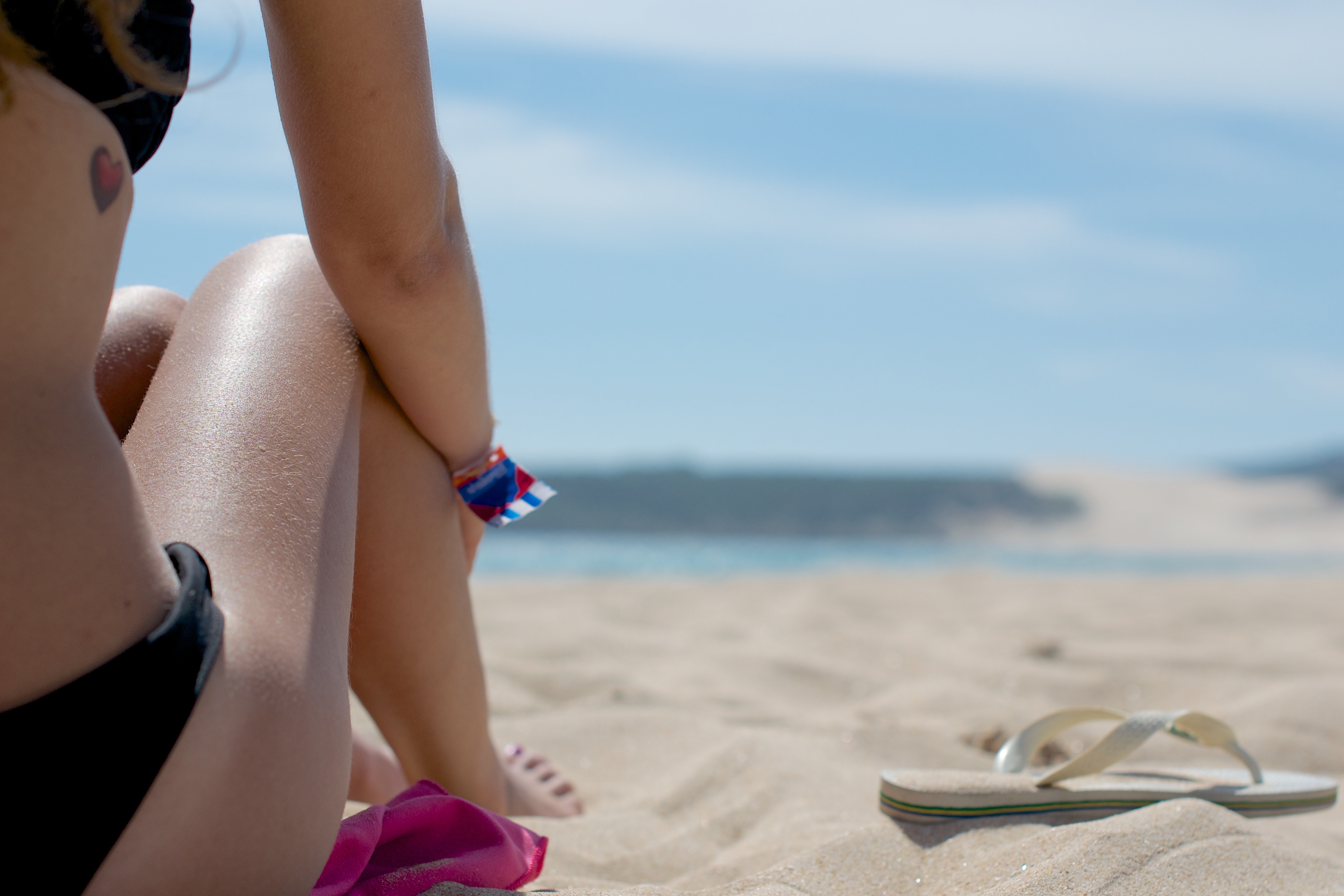
Photo by Salvador Martin Yeste on Unsplash
It’s summertime! And summertime means sunscreen time! But not all sunscreen is created equal. With literally thousands of options out there, how do we know which ones work well, and are also safe to use?
There’s a lot to consider when selecting the right sunscreen…….probably more to consider than you even want to think about! That’s why I’ve put together a list of 5 tips on how to select the next bottle of sunscreen for both you and your kids!
Download My 5 MUST-HAVE Smartphone Apps Guide Here
Tip #1 – Don’t Overload on the SPF
SPF stands for Sun Protection Factor, and simply doesn’t protect enough of the suns rays on it’s own. That’s because SPF is the measure used in protecting UVB rays, which are essentially the sunburn causing and non-melanoma skin cancer causing rays.
Not only are higher SPFs formulated with unnecessary chemicals, but they also aren’t necessarily as high as they claim to be. When Procter & Gamble conducted competitor research into SPF 100 products at 5 different labs, the company found that sunscreen with claims of 100+ SPF actually tested within the range of SPF 37 and SPF 75.
Higher SPFs also often misleads people in attempting to apply too little sunscreen infrequently, and stay out in the sun too long. In fact, the FDA is considering banning SPF values higher than 50+ stating that higher SPFs are “inherently misleading,” but no such regulation has been put into law.
I personally recommend a good 30 SPF sunscreen. It gives you the protection you need, and doesn’t contain as many chemicals.
#2 – Choose a Broad Spectrum Sunscreen
This tip is one that can be a little tricky as there are many sunscreens out there which claim to be Broad Spectrum, but they aren’t, or at least aren’t as effective as they should or could be.
Broad Spectrum means that the sunscreen protects agains both UVA AND UVB rays. It is the UVA rays which can cause a multitude of problems due to their deeper penetration into the skin and being harder to block with ingredients that are currently approved by the FDA.
Ultraviolet A rays not only accelerate skin aging, but they can also suppress the immune system, cause harmful free radicals to form in the skin, and put you at higher risk for developing melanoma.
When choosing a Broad Spectrum Sunscreen, be sure to select one that you know is from a company which continually tests their products to ensure that you are getting the most effective and safe option available.
If you would like a recommendation on an amazing SPF 30 sunscreen which is ALSO Broad Spectrum Coverage, please shoot me a Facebook message here!
Tip #3 – Opt For Mineral vs Chemical Sunscreen
There are many mineral based sunscreens out there to choose from, but far less than there are chemical based sunscreens. Mineral based sunscreens offer better protection in the sense that they essentially reflect the sun’s rays rather than lessen and disperse the suns rays much like chemical sunscreens do.
This means that, when applied appropriately, you are less likely to end up with that gorgeous tan than you are if you use chemical based sunscreen. However, being that a tan really is the first sign of skin damage, this really isn’t a bad thing. Of course it may be difficult to convince your (teenage) kids of that! 😉
Chemical based sunscreens use a combination of anywhere from 2 to 6 of the following active ingredients: oxybenzone, avobenzone, octisalate, octocrylene, homosalate and octinoxate. And two of these ingredients, oxybenzone and octinoxate, are partially responsible for the bleaching and death of the coral reefs and marine life in Hawaii, so they are likely to be banned from sunscreen sold in Hawaii soon. For more information on this, click here.
I don’t know about you, but if the chemicals used in chemical sunscreen are destroying coral reefs and marine life, I certainly don’t want to take my chances with what it’s doing to my body!
Mineral based sunscreens, on the other hand, commonly use zinc oxide and/or titanium dioxide. But there are some that do combine zinc oxide with chemical filters. The trick, though, is that it is best to find a mineral based sunscreen which does not contain nanoparticles.
Nanoparticles can be an inhalation risk, as well as can cause problems when absorbed into the skin. If the particles are too small and/or insoluble then they can cause organ damage.
That is why you want to look for a good, non-nanoparticle mineral sunscreen from a reputable company which you can trust.
Tip #4 – Steer Clear of Any Sunscreen Containing System Disrupters
Since sunscreen is meant to be applied in large portions all over the entire body, and several times a day, it is imperative to find a sunscreen that does not contain chemicals which can interfere with the endocrine system, reproductive system, etc.
Sunscreen ingredients, much like all skin care ingredients, soak through and into the skin, or in this case even “bake” into the skin, and can be detected in your blood, urine, and even mother’s breast milk. Several commonly used ingredients are suspected to mimic, or even block, hormones and others can cause allergic reactions on sensitive skin.
But sunscreen isn’t the only product that can contain these chemicals. Many, in fact MOST, are found throughout the entire personal care industry.
If you want to find out if your personal care products contain harmful chemicals then click the button below to pick up my FREE guide, “Are Your Personal Care Products Secretly Poisoning You and Your Family? My 5 Must-Have Smartphone Apps Every Good Mom Should Have to Keep Their Family Safe and Healthy”
Download My 5 MUST-HAVE Smartphone Apps Guide Here
Tip #5 – Avoid Sunscreens with Vitamin A/Retinyl Palmitate
Synthetic Vitamin A, known as retinyl palmitate, retinyl acetate, retinyl linoleate or retinol, is often used as an ingredient to combat aging and can sometimes be found in sunscreen. However, studies have indicated that this ingredient may trigger the growth of skin tumors and lesions when exposed to sunlight.
So say NO to this ingredient!
(Bonus) Tip #6 – Be sure to apply correctly!
Ok, so this one has nothing to do with how to select your sunscreen, but it DOES have to do with how much to apply so that you are receiving the FULL benefits it has to offer.
An adult should be applying 1oz of sunscreen during each application. For a visual reference, thats 1 shot glass full of sunscreen! Yes, that’s probably a lot more than you had thought!
And of course, be sure to apply as the frequently as called for in the directions – normally every 80 minutes when staying dry and every 40 minutes of swimming, but each sunscreen does vary so double check what yours says.
Don’t forget to apply ample amount to areas that burn easily such as the knees, feet, ears, elbows, and face!
If you’d like to try my go-to sunscreen, which meets all of the criteria above, please shoot me a message HERE!
I hope you have found some value in this list and that it will help you navigate the overwhelmingly large amount of sunscreen product choices available to you! If you have found value, please share by clicking on the icons below this article! I’d love to help others with their sunscreen selection as well!
Download My 5 MUST-HAVE Smartphone Apps Guide Here
For even more information on how sunscreen works, check out an awesome resource by clicking here!
Until next time……..
Here’s to achieving true wellness!

*Legal Disclaimer – All information provided above is for educational purposes only. Information should not be construed as medical or legal advice in any capacity and is not intended to prevent, diagnose, treat, or cure disease.